A 23-month-old girl with a red left eye
A 23-month-old girl was admitted for evaluation and treatment of a red left eye. The history of the chief complaint began with the onset of mild swelling of the left eye lids and erythema of the left eye with scant, clear discharge a few days earlier. The swelling seemed worse in the morning on awakening, and has persisted. There is no significant pain or itching associated with the problem, and she has been afebrile. She has no history of trauma to the area.

Pediatric Infectious Disease, Scott and White's Children's Health Center and Associate Professor of Pediatrics,
Texas A&M University, College of Medicine, Temple, Texas.
e-mail: jhbrien@aol.com
Her past medical history is complicated by having been diagnosed with biliary atresia as an infant, ultimately requiring a liver transplant eight months ago. As a result, she is on chronic immunosuppressive therapy with prednisone and tacrolimus (Prograf, Astellas). She also receives trimethoprim/sulfamethoxazole prophylaxis.
On review of systems, her mother related that the child had a minor cough and runny nose that began about the same time as the eye problem. There are no known allergies and her immunizations are somewhat delayed.
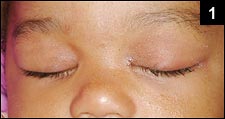
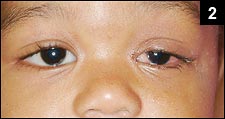
On examination, her vital signs are normal, with no fever or distress. The pertinent findings include the mild, painless swelling of her left eye lids as shown in figures 1 and 2. The left eye also is erythematous with a small amount of discharge (figure 3), and a mucopurulent nasal discharge is also noted (figure 4). Her eye had full range of motion and the fundoscopic exam was normal. The rest of her examination was unremarkable, but because of her immunosuppressed state, she had a computed tomography scan of the orbits (figures 5 and 6), showing some mild preseptal swelling and fluid in the maxillary and ethmoid sinuses.


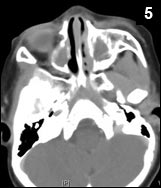

Lab tests included a normal complete blood count with blood culture pending. Eye swabs were sent for bacterial and viral cultures.
What’s Your Diagnosis?
- Bacterial preseptal cellulitis
- Viral conjunctivitis with sinusitis
- Oculoglandular syndrome
- Kawasaki disease
Answer
I realize we recently featured a case of enteroviral hemorrhagic conjunctivitis in July (figure 7), but this case has some additional teaching points. This turned out to be another enteroviral conjunctivitis, (choice B) that presented in a compromised patient with some elements concerning for possible bacterial cellulitis of the preseptal tissues, which provoked more imaging and lab tests that an otherwise “normal” patient might have had. Because of this, the patient received empiric intravenous antibiotics (ceftriaxone plus clindamycin) and went home 48 hours later on comparable oral therapy, even though all bacterial cultures were negative prior to discharge, which is not an unusual scenario. This case occurred a few years ago, before we had polymerase chain reaction (PCR) capability to rapidly detect enterovirus, but the viral culture grew enterovirus after discharge. I am writing this in September, and we are still seeing cases of enteroviral aseptic meningitis and other febrile diseases requiring some patients to be admitted to the hospital. Perhaps it is a false perception driven by the ease of detection of many viruses that we enjoy these days, but it seems that we have seen an unusually active summer of enterovirus infections this year.
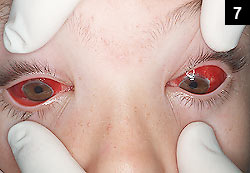
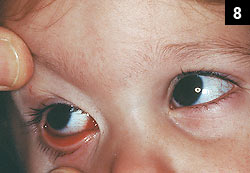
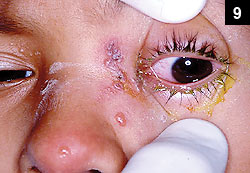
This case could have just as likely been caused adenovirus (figure 8), influenza, parainfluenza, varicella zoster (figure 9) or just about any other virus, and it probably doesn’t really make much difference, because from a practical standpoint, we really just want to know if this is something that is treatable and/or is going to progress, like a severe bacterial infection (figure 10) that could potentially kill a patient whose immune system is impaired. Like all things in life, infections represent a dynamic process with a beginning that may look fairly mild. Therefore, high-risk patients are likely to come to the hospital before the problem is more clearly defined. Nowadays, the diagnosis of many viral infections can be reasonably made with rapid detection techniques, such as PCR, allowing for some earlier decisions regarding hospitalization and treatment.

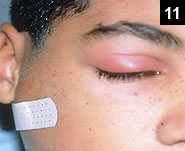
Oculoglandular syndrome describes conjunctivitis with ipsilateral preauricular adenopathy (figure 11). One of the most frequent causes is cat-scratch disease, which may reveal a granulomatous lesion as shown in figure 12.
Kawasaki disease, has a nonexudative conjunctivitis as a criteria (figure 13), but the patient presented had no other features of Kawasaki disease, and it should be quickly ruled out.
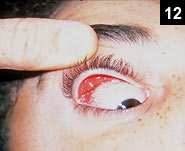
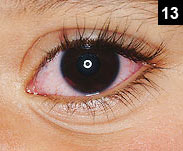
Columnist comments
Thomas Weller, MD, died on Aug. 23, 2008 at age 93 years. More than 2,400,000 people die every year in this country. Many of them are physicians. Who was Thomas Weller, and why would he deserve special mention? If you have enjoyed a life free from many vaccine-preventable diseases, particularly viral diseases such as polio, rubella, varicella and others, then you owe Dr. Weller a word of thanks. Along with John Franklin Enders and Frederick Chapman Robbins, Weller won the Nobel Prize in Medicine and Physiology in 1954 for work in developing the technique for culturing viruses, particularly poliovirus. This led to the development of the killed virus polio vaccine by Jonas Edward Salk and later, the live-attenuated polio vaccine by Albert Bruce Sabin.
Most of Dr. Weller’s career was spent at the Harvard School of Public Health, but he also served in the Army Medical Corps during World War II from 1942-1945. His commitment to the Army Medical Department lasted well beyond his years on active duty. I had the high honor to hear him lecture at the Tropical Medicine course at the Walter Reed Army Institute of Research when I was a Pediatric Infectious Disease Fellow there in 1983. I still have a copy of his rather unassuming, one-page curriculum vitae from that visit, which simply lists the Nobel Prize along with several other awards and the usual biographical and educational information. My exposure to Dr. Weller one summer day in 1983 does not make me an expert on him as a person, but my recollection of him was very positive. He clearly enjoyed teaching us in that course with an unassuming style, yet we knew we were in the presence of greatness.
As in this viral conjunctivitis with sinusitis case, we often take for granted the ability to grow viruses or rapidly detect their presence, which often changes the course of therapy. We do this on the shoulders of these pioneers of modern virology, such as Thomas Weller, former Major, U.S. Army Medical Corps.
